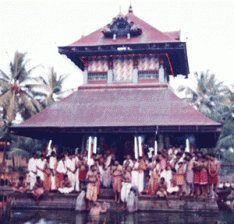Architecture


One of the Largest Bell In Asia
Parsvamantapam is the next hall in front of the main temple inside the periphery. At the Southern end of Parswamantapam is erected Twelve Pillar Silver Mantapam for Kalyana Utsavam. The Chandeliers and Electric Globes and Domes add to the decor of the Parsvamantapam. The Exquisite Carvings on the inner ceilings depicting episodes from the Ramayana, Mahabharata, Bhagavatham etc, make Namaskara Mantapam and its flanks more attractive. In the centre of Vimana Shaped Sreekovil, the sanctum sanctorum, is seen the beautiful throne artistically finished on a single stone and coated with sandal paste.
The Northern Tower (gopuram)
It is interesting to note that the richly decorated monumental tower on the Northern side of the temple is done up in a Pagoda style that is influenced by the Indo Tibetan architecture. Elegant and double storied, the Northern tower has a copper plated roof. Rich wooden carvings by the master craftsmen of South India depicting scenes from the Holy relics are the salient features of the Northern temple tower.
Details

Kulamandapam
Kulamandapam is situated at the centre of the pond which is known as Papanasam Lake just outside the temple east gate. It is the place where the temple deities are brought twice a year on the 8th day of the Arat Festival. On the 8th day of the temple festival (Arat Day), the temple deities are shifted to a throne installed on a make-shift twin boats joined together and profusely decorated with cloth, garlands of flowers, etc. and taken to the mandapam at the centre of the lake. At the mandapam, Deities are seated on the upper floor on a throne specially decorated for the purpose. Pujas and artis are then performed for the Deities along with a purification homam(yajna) and puja for the lake. Symbolically representing the Lord, the Chief Priest carries the Chakra and Saligramam on his head and take a plunge in the lake from the mandapam steps. This is called Chakra Snanam and it is believed that it purifies the lake water and converts it to Theertham. This theertham is splashed on the persons witnessing this ritual. Many persons take a dip in the lake theertham to purify their being. It is believed that the splashing of the lake water theertham or taking a dip in the lake after the Chakra Snanam absolves them of all sins and purify their being by removing all the bad and negative traits. The devotees believes that the Lord Venkatachalapathi will not remain at a single place for more time and therefore god should be shifted to another place and for this, the deities are symbolically taken to boats and cross the water and shifted to another place outside the temple in the Kula Mandapam at the centre of the pond. After the sojourn at the Kulamandapam in the temple pond, the pujas and artis are performed and the Deities proceed to the main temple in the Golden Palanquin, the Chakra and the Representative Deity on two elephants in a grand procession led by vaadhyamelam/panchavadhyam and a sea of community members and the Garuda Vahana Puja is performed in the temple. Therefore Kulamandapam has a very good significance in our temple.
More Details
In the outer most periphery is housed the Sukratindra Sadan, the Bungalow for Swamijis to camp during their visits, Saraswati Nilayam, which houses the Temple Library, Santhi Kulam, the bathing tank for temple priests, Dove cot, Mini Garden, Elephant Shed, Gosala, vast Agrasalas, Stores, Yogasala, Treasury, Vessel Store, Main Office, Veda Patasala, Vyasa Mandir, Vahanas-Gallery, Vimana House, Washing Tank, Huge Uootupura, & Main Flower Garden. The next Prakara is wide open ground for Sheeveli and Vahana Pooja . Adjacent to it is Kalyana Utsavaveethi through which the Festival deities are taken in Palanquin in a procession before and after Kalyanotsavam with all temple Paraphernalia. Next to it is Pallaku Pooja Panthal. The biggest bronze bell and one of the biggest Deepasthambhams in India are seen in the Nada Panthal Lane. Inside these are minor shrines, Yakshi Peetam, Tulasi Tara, Vana Bhojanasala, Shatabdi Panthal, & Yagna Sala.






